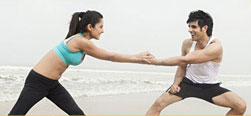

Leave your details below and we'll get back to you!
*All fields are mandatoryFitness Plans
Yoga Poses for Diabetes
These 5 yoga poses to keep diabetes under control!
Regular yoga practice can help reduce the level of sugar in the blood, along with lowering blood pressure, keeping your weight in check, reducing the severity of the symptoms and slowing the rate of progression of the disease. It also lessens the possibility of further complications. Stress is one of the major reasons for diabetes. The practice of yoga is also proven to lose weight and slow the process of fat accumulation.
Surya namaskar and kapal bhati pranayama are some of the most effective yoga poses that help weight loss. Since obesity is a major contributing factor for diabetes, doing yoga to keep your weight in check is the key.
#1 Pranayam
Breathing in deeply and breathing out helps oxygenate your blood, and improves circulation. It also calms the mind and gives your rattled nerves some much needed rest. Here are few more health benefits of pranayama you should be aware of.
Steps to do this pose
- Sit on a yoga mat on the floor. Fold your legs in either padmasana or sit cross legged.
- Now straighten your back, keep your chin parallel to the floor, place your hands on your knees with your palms facing upwards and close your eyes.
- Breath in deep and hold your breath for five counts. Exhale slowly. Repeat this process at least ten times.
- Once you are done, rub your palms together till they are warm, and place them on your eyes. Now slowly open them and smile.
#2 Setubandhasana
This pose not only helps keep one’s blood pressure in control it also helps to relax the mind, improves digestion, relieves the symptoms of menopause in women and stretches the neck and spine.
Steps to do this pose:
- Lie flat on your yoga mat, with your feet flat on the floor.
- Now exhale and push up, and off the floor with your feet.
- Raise your body up such that your neck and head are flat on the mat and the rest of your body is in the air.
- You can use your hands to push down for added support.
- If you are flexible you can even clasp your fingers just below your raised back for that added stretch.
- The key here is to not overexert or hurt yourself while doing this pose.
Tip: Avoid doing this pose if you have a neck or back injury.
#3 Balasana
Known as the child’s pose this is a great stress buster. It gently stretches the hips, thighs and ankles, calms the mind and helps relieve stress and fatigue. It is also a great remedy for that lower back pain you might have from long hours of sitting.
Steps to do the pose:
- Sit on the floor with your weight on your knees. Now flatten your feet onto the floor and sit on your heels.
- Spread your thighs apart a little. Exhale and bend forward from your waist.
- Let your stomach rest on your thighs and extend your back. Now stretch out your arms in front of you to elongate the back.
- You can also rest your forehead on the floor. This may require flexibility, so don’t push your body beyond its limit. You will get better with time.
- This is a resting pose so you should ideally breath at a normal pace. You can stay in this pose for as long as three minutes or as little as five counts
Tip: If you are pregnant, have a knee injury or have diarrhoea do not do this pose.
#4 Vajrasana
This is a simple pose that is great to relax the mind, improve digestion and massages the kanda.
Steps to do this pose:
- All you need to do is place a yoga mat on the floor.
- Kneel on the mat, and let the top surface of your feet touch the mat, such that your heels are pointing upwards.
- Now gently place your buttocks on your heels. It is important to note that your heels are on either side of your anus.
- Now place both your palms on your knees, facing downwards. Close your eye and breath in deeply at a steady rate.
#5 Paschimotasana
This is a forward bending pose that helps the blood to flow to the face. Apart from that, it helps the stomach function better, strengthens the thigh muscles and relaxes the back and arms.
Steps to do this pose:
- Sit with your legs stretched out on the floor. Next hold the big toe of your feet with your index finger and thumb.
- Now, exhale and slowly bend forward and try to touch your forehead to your knees.
- The key is that your elbows should touch the floor.Do not breath in.
- Stay in this position for five counts and inhale as you rise back to the sitting position.
Tips to keep in mind: If you have any type of back pain or complaints with your spine, do not do this pose. Moreover, be easy on yourself, you might not be able to touch your knees with your forehead. Know that if you keep at it you will regain your flexibility and be able to do the pose properly.
Disclaimer: All plans included in this section are generic and would require consultation with an expert before being adopted.










